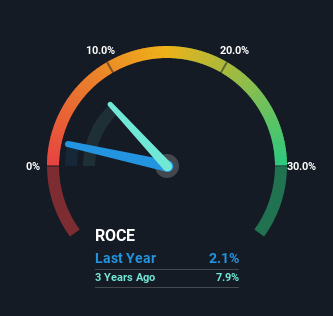- Saudi Arabia
- /
- Healthcare Services
- /
- SASE:4009
Returns On Capital At Middle East Healthcare (TADAWUL:4009) Paint A Concerning Picture

Finding a business that has the potential to grow substantially is not easy, but it is possible if we look at a few key financial metrics. Firstly, we'd want to identify a growing return on capital employed (ROCE) and then alongside that, an ever-increasing base of capital employed. This shows us that it's a compounding machine, able to continually reinvest its earnings back into the business and generate higher returns. In light of that, when we looked at Middle East Healthcare (TADAWUL:4009) and its ROCE trend, we weren't exactly thrilled.
Return On Capital Employed (ROCE): What is it?
For those that aren't sure what ROCE is, it measures the amount of pre-tax profits a company can generate from the capital employed in its business. The formula for this calculation on Middle East Healthcare is:
Return on Capital Employed = Earnings Before Interest and Tax (EBIT) ÷ (Total Assets - Current Liabilities)
0.021 = ر.س54m ÷ (ر.س4.0b - ر.س1.4b) (Based on the trailing twelve months to December 2021).
Thus, Middle East Healthcare has an ROCE of 2.1%. In absolute terms, that's a low return and it also under-performs the Healthcare industry average of 12%.
See our latest analysis for Middle East Healthcare

In the above chart we have measured Middle East Healthcare's prior ROCE against its prior performance, but the future is arguably more important. If you'd like to see what analysts are forecasting going forward, you should check out our free report for Middle East Healthcare.
So How Is Middle East Healthcare's ROCE Trending?
On the surface, the trend of ROCE at Middle East Healthcare doesn't inspire confidence. Around five years ago the returns on capital were 18%, but since then they've fallen to 2.1%. However it looks like Middle East Healthcare might be reinvesting for long term growth because while capital employed has increased, the company's sales haven't changed much in the last 12 months. It's worth keeping an eye on the company's earnings from here on to see if these investments do end up contributing to the bottom line.
On a side note, Middle East Healthcare's current liabilities have increased over the last five years to 34% of total assets, effectively distorting the ROCE to some degree. If current liabilities hadn't increased as much as they did, the ROCE could actually be even lower. Keep an eye on this ratio, because the business could encounter some new risks if this metric gets too high.
What We Can Learn From Middle East Healthcare's ROCE
In summary, Middle East Healthcare is reinvesting funds back into the business for growth but unfortunately it looks like sales haven't increased much just yet. And in the last five years, the stock has given away 50% so the market doesn't look too hopeful on these trends strengthening any time soon. Therefore based on the analysis done in this article, we don't think Middle East Healthcare has the makings of a multi-bagger.
If you want to know some of the risks facing Middle East Healthcare we've found 2 warning signs (1 doesn't sit too well with us!) that you should be aware of before investing here.
While Middle East Healthcare may not currently earn the highest returns, we've compiled a list of companies that currently earn more than 25% return on equity. Check out this free list here.
If you're looking to trade Middle East Healthcare, open an account with the lowest-cost platform trusted by professionals, Interactive Brokers.
With clients in over 200 countries and territories, and access to 160 markets, IBKR lets you trade stocks, options, futures, forex, bonds and funds from a single integrated account.
Enjoy no hidden fees, no account minimums, and FX conversion rates as low as 0.03%, far better than what most brokers offer.
Sponsored ContentNew: Manage All Your Stock Portfolios in One Place
We've created the ultimate portfolio companion for stock investors, and it's free.
• Connect an unlimited number of Portfolios and see your total in one currency
• Be alerted to new Warning Signs or Risks via email or mobile
• Track the Fair Value of your stocks
Have feedback on this article? Concerned about the content? Get in touch with us directly. Alternatively, email editorial-team (at) simplywallst.com.
This article by Simply Wall St is general in nature. We provide commentary based on historical data and analyst forecasts only using an unbiased methodology and our articles are not intended to be financial advice. It does not constitute a recommendation to buy or sell any stock, and does not take account of your objectives, or your financial situation. We aim to bring you long-term focused analysis driven by fundamental data. Note that our analysis may not factor in the latest price-sensitive company announcements or qualitative material. Simply Wall St has no position in any stocks mentioned.
About SASE:4009
Middle East Healthcare
A healthcare provider, owns and operates a network of hospitals under the Saudi German Hospital name in the Middle East and North Africa.
Undervalued with proven track record.
Market Insights
Community Narratives



